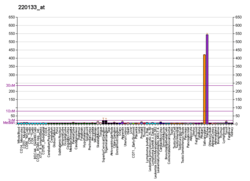ODAM (gene)
Odontogenic ameloblast-associated protein is a protein that in humans is encoded by the ODAM gene.[5][6]
References
- 1 2 3 GRCh38: Ensembl release 89: ENSG00000109205 - Ensembl, May 2017
- 1 2 3 GRCm38: Ensembl release 89: ENSMUSG00000009580 - Ensembl, May 2017
- ↑ "Human PubMed Reference:".
- ↑ "Mouse PubMed Reference:".
- ↑ Solomon A, Murphy CL, Weaver K, Weiss DT, Hrncic R, Eulitz M, Donnell RL, Sletten K, Westermark G, Westermark P (Dec 2003). "Calcifying epithelial odontogenic (Pindborg) tumor-associated amyloid consists of a novel human protein". J Lab Clin Med. 142 (5): 348–55. doi:10.1016/S0022-2143(03)00149-5. PMID 14647039.
- ↑ "Entrez Gene: ODAM odontogenic, ameloblast asssociated [sic]". Retrieved 2013-03-31.
Further reading
- Moffatt P, Smith CE, Sooknanan R, et al. (2006). "Identification of secreted and membrane proteins in the rat incisor enamel organ using a signal-trap screening approach". Eur. J. Oral Sci. 114 Suppl 1: 139–46, discussion 164–5, 380–1. doi:10.1111/j.1600-0722.2006.00318.x. PMID 16674676.
- Ota T, Suzuki Y, Nishikawa T, et al. (2004). "Complete sequencing and characterization of 21,243 full-length human cDNAs". Nat. Genet. 36 (1): 40–5. doi:10.1038/ng1285. PMID 14702039.
- Strausberg RL, Feingold EA, Grouse LH, et al. (2003). "Generation and initial analysis of more than 15,000 full-length human and mouse cDNA sequences". Proc. Natl. Acad. Sci. U.S.A. 99 (26): 16899–903. doi:10.1073/pnas.242603899. PMC 139241. PMID 12477932.
- Harrington JJ, Sherf B, Rundlett S, et al. (2001). "Creation of genome-wide protein expression libraries using random activation of gene expression". Nat. Biotechnol. 19 (5): 440–5. doi:10.1038/88107. PMID 11329013.
- Suzuki Y, Yoshitomo-Nakagawa K, Maruyama K, et al. (1997). "Construction and characterization of a full length-enriched and a 5'-end-enriched cDNA library". Gene. 200 (1–2): 149–56. doi:10.1016/S0378-1119(97)00411-3. PMID 9373149.
- Hillier LD, Lennon G, Becker M, et al. (1997). "Generation and analysis of 280,000 human expressed sequence tags". Genome Res. 6 (9): 807–28. doi:10.1101/gr.6.9.807. PMID 8889549.
- Maruyama K, Sugano S (1994). "Oligo-capping: a simple method to replace the cap structure of eukaryotic mRNAs with oligoribonucleotides". Gene. 138 (1–2): 171–4. doi:10.1016/0378-1119(94)90802-8. PMID 8125298.
This article is issued from
Wikipedia.
The text is licensed under Creative Commons - Attribution - Sharealike.
Additional terms may apply for the media files.




